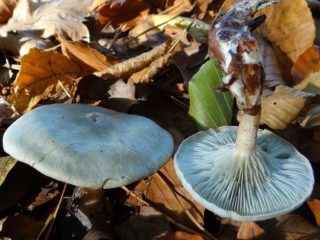Content
Talkers are a genus of mushrooms that includes a huge variety of specimens. Among them there are both edible and poisonous. The pale-colored or slightly colored talker is especially dangerous. This variety belongs to the Ryadovkov family and is widespread in most regions of Russia.
Where do pale-colored talkers grow?
Faintly colored talkers grow throughout Europe.In Russia they can be found in broad-leaved, mixed and coniferous forests of Siberia and the Far Eastern region. Favorite places for mushrooms to appear are leafy areas under oaks, willows, spruces, and birches. Representatives of the Ryadovkov family most often grow alone, but sometimes they can form small groups. Fruiting lasts from the beginning of August to the end of October.
What do pale-colored talkers look like?
The caps of young pale-colored talkers are funnel-shaped with a clearly defined dark circle in the center. Their diameter does not exceed 5 cm. As they grow, the convex cap becomes even more recessed in the center and takes the shape of a funnel. Its edges begin to bend upward. The color varies from whitish-gray to ashen, depending on weather conditions. With strong humidity, it becomes darker and the surface becomes covered with mucus. In dry weather, the cap is very light and shows signs of dehydration. The thin and bare leg does not exceed 6 cm. Its shape in a young pale-colored talker is club-shaped; with age it transforms into a cylindrical shape, somewhat widening towards the base. The thin, watery, white pulp emits a sharp, unpleasant musty smell of dust from a neglected barn. Gray plates are often located on the inside of the cap and extend slightly downwards onto the stem.
Is it possible to eat pale-colored talkers?
Pale-colored talkers are unsuitable for food, as they contain toxic substances. After eating a dish of these mushrooms, a person gets severe food poisoning. Some sources are inedible, others are poisonous. In any case, the species should not be eaten.
How to distinguish pale-colored talkers
The pale-colored relatives differ from the edible representatives of the Ryadovkov family by the dryness of the pulp on the cut. If, when broken, the fruiting body releases milky juice, then it is edible. In this way, it is possible to distinguish between the pale-colored and winter talkers, which have a strong resemblance at a young age. This main rule will help not to confuse edible and conditionally edible mushrooms of the Ordinaceae family from inedible and poisonous ones. In appearance it is similar to the slightly colored grooved talker. However, the latter is smaller in size, and the surface of its cap becomes wrinkled after rain. This is a poisonous variety.
Symptoms of poisoning
When poisoned with pale-colored talker, the following symptoms occur:
- severe dizziness and headaches;
- apathy, weakness of the whole body;
- a sharp decrease in blood pressure;
- increased salivation and sweating;
- cardiac dysfunction;
- anxiety attacks, manifestations of aggression, confusion or, conversely, lethargy, severe drowsiness;
- pain in the abdomen;
- vomiting, diarrhea, nausea;
- temperature increase;
- loss of consciousness - in particularly serious cases.
Secondary symptoms of poisoning by the pale-colored talker can be chills, muscle tremors, and frequent urination.
First aid for poisoning
If the symptoms described above caused by the consumption of mushrooms are present, the patient must be put to bed and gastric lavage and intestinal cleansing done:
- Drink plenty of water: 4 - 5 tbsp. - in small sips.
- Press on the root of the tongue with your fingers and induce vomiting.
- Take a laxative and do an enema.
Conclusion
The pale-colored govorushka contains toxic compounds that have not yet been fully studied by mycologists, so it should never be eaten. When picking mushrooms, you should be extremely vigilant, because food poisoning is considered one of the most dangerous to human health.











